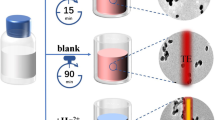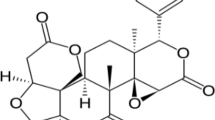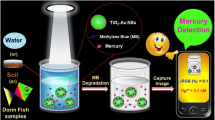Abstract
A novel portable smartphone-assisted colorimetric method was reported for the determination of Hg2+ with good analytical performance. A Zr(IV)-based metal–organic framework functionalized with amino groups (NH2-UiO-66) has been adopted as a supporting platform to anchor gold nanoparticles (AuNPs), avoiding the migration and aggregation of AuNPs. With the addition of Hg2+, the formation of gold amalgam proved possible to enhance peroxidase-like activity of the composite (AuNPs/NH2-UiO-66), accelerating the oxidization of zymolyte 3,3′,5,5′-tetramethylbenzidine (TMB). In the meantime, the color of the reaction solution turned a vivid blue, and the red, green, and blue (RGB) values of the solution color changed accordingly. On account of this strategy, the quantitative detection of Hg2+ could be achieved. After the optimization of the experiment conditions, the average color intensity (Ic) resulting from RGB values was linear related to the concentration of Hg2+ from 10 to 100 nM, accompanied with a detection limit (LOD) down to 5.4 nM calculated by 3σ/S. The successful application of the designed method has been promoted to detect Hg2+ in some water samples, displaying a great potential in practical application. Furthermore, the use of a smartphone made our proposed method simple and accurate, and thus puts forward a possible way for in situ and real-time monitoring.
Graphical Abstract
A portable smartphone-assisted RGB colorimetric method for Hg2+ detection based on Hg2+-enhanced peroxidase-like activity of AuNPs modified on NH2-UiO-66.






Similar content being viewed by others
References
Okpala C, Sardo G, Vitale S, Bono G, Arukwe A. Hazardous properties and toxicological update of mercury: from fish food to human health safety perspective. Crit Rev Food Sci. 2018;58(12):1986–2001.
Syversen T, Kaur P. The toxicology of mercury and its compounds. J Trace Elem Med Bio. 2012;26(4):215–26.
Zheng H, Hong JJ, Luo XL, Li S, Wang MX, Yang BY, et al. Combination of sequential cloud point extraction and hydride generation atomic fluorescence spectrometry for preconcentration and determination of inorganic and methyl mercury in water samples. Microchem J. 2019;145:806–12.
Gao XS, Dai JY, Zhao HY, Zhu J, Luo L, Zhang R, et al. Synthesis of MoS2 nanosheets for mercury speciation analysis by HPLC-UV-HG-AFS. RSC Adv. 2018;8(33):18364–71.
Liu SP, Zhang PP, Liu HC, Wang W, Lian KQ. Determination of trace mercury in cosmetics by suspension-sampling hydride generation atomic fluorescence spectrometry. Asian J Chem. 2013;25(13):7315–8.
Xie MY, Hao XT, Jiang X, Liu WT, Liu TT, Zheng H, et al. Ultrasound-assisted dual-cloud point extraction with high-performance liquid chromatography-hydride generation atomic fluorescence spectrometry for mercury speciation analysis in environmental water and soil samples. J Sep Sci. 2021;44(12):2457–64.
Thongsaw A, Sananmuang R, Udnan Y, Ross GM, Chaiyasith WC. Speciation of mercury in water and freshwater fish samples using two-step hollow fiber liquid phase microextraction with electrothermal atomic absorption spectrometry. Spectroc Acta Pt B-Atom Spectr. 2019;152:102–8.
Mielcarek K, Nowakowski P, Puscion-Jakubik A, Gromkowska-Kepka KJ, Soroczynska J, Markiewicz-Zukowska R, et al. Arsenic, cadmium, lead and mercury content and health risk assessment of consuming freshwater fish with elements of chemometric analysis. Food Chem. 2022;379: 132167.
Lv ZH, Liu JX, Mao XF, Na X, Qian YZ. Portable and miniature mercury analyzer using direct sampling inbuilt-metal ceramic electrothermal vaporization. Anal Chim Acta. 2022;1231: 340444.
Ozdemir S, Kilinc E, Celik KS, Okumus V, Soylak M. Simultaneous preconcentrations of Co2+, Cr6+, Hg2+ and Pb2+ ions by Bacillus altitudinis immobilized nanodiamond prior to their determinations in food samples by ICP-OES. Food Chem. 2017;215:447–53.
Goudarzi S, Fahimirad B, Rajabi M, Baigenzhenov O, Hosseini-Bandegharaei A. Recruiting chemical grafting method for surface modification of stainless steel to fabricate a selective sorbent for solid phase microextraction of mercury metal ion. Environ Science Pollut R. 2023;30(2):3121–32.
Cai ZQ, Wang Z. Evaluation of solution anode glow discharge as a vapor generator in ICP-OES procedures: application to highly sensitive determination of Cd and Hg. Anal Chim Acta. 2022;1203: 339724.
Lazovic M, Tomovic V, Vasiljevic I, Kecojevic I, Tomovic M, Martinovic A, et al. Cadmium, lead, mercury and arsenic in fresh vegetables and vegetable products intended for human consumption in the Republic of Serbia, 2015–2017. Food Addit Contam B. 2023;16(2):102–19.
Zhang XN, Zhu MC, Jiang YJ, Wang X, Guo ZM, Shi JY, et al. Simple electrochemical sensing for mercury ions in dairy product using optimal Cu2+-based metal-organic frameworks as signal reporting. J Hazard Mater. 2020;400: 123222.
Elsebai B, Ghica ME, Abbas MN, Brett CMA. Novel amperometric mercury-selective sensor based on organic chelator ionophore. Molecules. 2023;28(6):2809.
Xia YX, Li JT, Zhu GB, Yi YH. Innovative strategy based on novel Ti3C2Tx MXenes nanoribbons/carbon nanotubes hybrids for anodic stripping voltammetry sensing of mercury ion. Sens Actuator B-Chem. 2022;355: 131247.
Yang MY, Sun CX, Yang LY, Zheng SR, Fu HY. Hierarchical porous loofah-like carbon with sulfhydryl functionality for electrochemical detection of trace mercury in water. Anal Chim Acta. 2023;1276: 341646.
Gao YY, Yi N, Ou ZZ, Li ZY, Ma TT, Jia HD, et al. Thioacetal modified phenanthroimidazole as fluorescence probe for rapid and sensitive detection of Hg2+ in aqueous solution assisted by surfactant. Sens Actuator B-Chem. 2018;267:136–44.
Li YX, Ren ZJ, Ge YS, Di CX, Zhou J, Wu J, et al. A novel peptide fluorescent probe based on different fluorescence responses for detection of mercury species and hydrogen sulfide. Microchem J. 2023;184: 108160.
Nehzati S, Dolgova NV, Young CG, James AK, Cotelesage JJH, Sokaras D, et al. Mercury Lα1 high energy resolution fluorescence detected X-ray absorption spectroscopy: a versatile speciation probe for mercury. Inorg Chem. 2022;61(13):5201–14.
Yadav S, Choudhary N, Sonpal V, Paital AR. Engineering excitation-independent turn-on fluorescent probe for mercury: functionalized dendritic silica doped with red-emissive carbon dots towards simultaneous detection and remediation with biosensing application. Chem Eng J. 2023;471: 144715.
Shih TT, Chen JY, Luo YT, Lin CH, Liu YH, Su YA, et al. Development of a titanium dioxide-assisted preconcentration/on-site vapor-generation chip hyphenated with inductively coupled plasma-mass spectrometry for online determination of mercuric ions in urine samples. Anal Chim Acta. 2019;1063:82–90.
Cai WP, Wang YJ, Feng Y, Liu P, Dong SF, Meng B, et al. Extraction and quantification of nanoparticulate mercury in natural soils. Environ Sci Technol. 2022;56(3):1763–70.
Wang Y, Zhu AL, Fang YY, Fan CJ, Guo YL, Tan ZQ, et al. Dithizone-functionalized C18 online solid-phase extraction-HPLC-ICP-MS for speciation of ultra-trace organic and inorganic mercury in cereals and environmental samples. J Environ Sci. 2022;115:403–10.
Ding YJ, Wang SS, Li JH, Chen LX. Nanomaterial-based optical sensors for mercury ions. TrAC-Trends Anal Chem. 2016;82:175–90.
Wu Y, Feng J, Hu G, Zhang E, Yu HH. Colorimetric sensors for chemical and biological sensing applications. Sensors. 2023;23(5):2749.
Zhang ZY, Wang H, Chen ZP, Wang XY, Choo J, Chen LX. Plasmonic colorimetric sensors based on etching and growth of noble metal nanoparticles: strategies and applications. Biosens Bioelectron. 2018;114:52–65.
Monisha, Shrivas K, Kant T, Patel S, Devi R, Dahariya NS, et al. Inkjet-printed paper-based colorimetric sensor coupled with smartphone for determination of mercury (Hg2+). J Hazard Mater. 2021;414:125440.
Yuan M, Li C, Wang MX, Cao H, Ye T, Hao LL, et al. Low-cost, portable, on-site fluorescent detection of As(III) by a paper-based microfluidic device based on aptamer and smartphone imaging. Microchim Acta. 2023;190:109.
Wang SS, Ding YW, Zhang L, Cheng YL, Deng Y, Jiang Q, et al. Combination of colorimetry, inner filter effect-induced fluorometry and smartphone-based digital image analysis: a versatile and reliable strategy for multi-mode visualization of food dyes. J Hazard Mater. 2023;445: 130563.
Wang SS, Wang HL, Yuan ZH, Li MY, Gao HR, Shan LJJ, et al. Colorimetry combined with inner filter effect-based fluorometry: a versatile and robust strategy for multimode visualization of food dyes. ACS Appl Mater Interfaces. 2022;14(51):57251–64.
Wang TT, Lio CK, Huang H, Wang RY, Zhou H, Luo P, et al. A feasible image-based colorimetric assay using a smartphone RGB camera for point-of-care monitoring of diabetes. Talanta. 2020;206: 120211.
Yang CH, Yang YJ, Zhao GZ, Wang H, Dai Y, Huang XW. A low-cost microfluidic-based detection device for rapid identification and quantification of biomarkers-based on a smartphone. Biosensors-Basel. 2023;13:753.
Yan LX, Chen ZP, Zhang ZY, Qu CL, Chen LX, Shen DZ. Fluorescent sensing of mercury(II) based on formation of catalytic gold nanoparticles. Analyst. 2013;138(15):4280–3.
Huang YQ, Fu S, Wang YS, Xue JH, Xiao XL, Chen SH, et al. Protamine-gold nanoclusters as peroxidase mimics and the selective enhancement of their activity by mercury ions for highly sensitive colorimetric assay of Hg(II). Anal Bioanal Chem. 2018;410(28):7385–94.
Wang SS, Chen ZP, Choo J, Chen LX. Naked-eye sensitive ELISA-like assay based on gold-enhanced peroxidase-like immunogold activity. Anal Bioanal Chem. 2016;408(4):1015–22.
Li YM, Hu JH, Zhu MZ. Confining atomically precise nanoclusters in metal-organic frameworks for advanced catalysis. Coord Chem Rev. 2023;495: 215364.
Sutton AL, Melag L, Sadiq MM, Hill MR. Capture, storage, and release of oxygen by Metal-Organic Frameworks (MOFs). Angew Chem Int Ed. 2022;61: e2022083.
Li S, Ma JP, Wu GG, Li JH, Ostovan A, Song ZH, et al. Determination of anionic perfluorinated compounds in water samples using cationic fluorinated metal organic framework membrane coupled with UHPLC-MS/MS. J Hazard Mater. 2022;429: 128333.
Chai HN, Yu K, Zhao YM, Zhang ZY, Wang SS, Huang CA, et al. MOF-On-MOF dual enzyme-mimic nanozyme with enhanced cascade catalysis for colorimetric/chemiluminescent dual-mode aptasensing. Anal Chem. 2023;95(28):10785–94.
Yang J, Yang LT, Ye HL, Zhao FQ, Zeng BZ. Highly dispersed AuPd alloy nanoparticles immobilized on UiO-66-NH2 metal-organic framework for the detection of nitrite. Electrochim Acta. 2016;219:647–54.
Shi XY, Zhang XD, Bi FK, Zheng ZH, Sheng LJ, Xu JC, et al. Effective toluene adsorption over defective UiO-66-NH2: an experimental and computational exploration. J Mol Liq. 2020;316: 113812.
Zhai YZ, Li YJ, Huang XK, Hou JY, Li HS, Ai SY. Colorimetric and ratiometric fluorescent dual-mode sensitive detection of Hg2+ based on UiO-66-NH2@Au composite. Spectrochim Acta A. 2022;275: 121187.
Sarker M, Song JY, Jhung SH. Carboxylic-acid-functionalized UiO-66-NH2: a promising adsorbent for both aqueous- and non-aqueous-phase adsorptions. Chem Eng J. 2018;331:124–31.
Qi K, Hou RZ, Zaman S, Qiu YB, Xia BY, Duan HW. Construction of metal-organic framework/conductive polymer hybrid for all-solid-state fabric supercapacitor. ACS Appl Mater Interfaces. 2018;10(21):18021–8.
Du JJ, Wang ZK, Fan JL, Peng XJ. Gold nanoparticle-based colorimetric detection of mercury ion via coordination chemistry. Sens Actuator B-Chem. 2015;212:481–6.
Chen XJ, Zu YB, Xie H, Kemas AM, Gao ZQ. Coordination of mercury(II) to gold nanoparticle associated nitrotriazole towards sensitive colorimetric detection of mercuric ion with a tunable dynamic range. Analyst. 2011;136(8):1690–6.
Li Y, Wu P, Xu H, Zhang ZP, Zhong XH. Highly selective and sensitive visualizable detection of Hg2+ based on anti-aggregation of gold nanoparticles. Talanta. 2011;84(2):508–12.
Kataria R, Sethuraman K, Vashisht D, Vashisht A, Mehta SK, Gupta A. Colorimetric detection of mercury ions based on anti-aggregation of gold nanoparticles using 3, 5-dimethyl-1-thiocarboxamidepyrazole. Microchem J. 2019;148:299–305.
Ismail M, Khan MI, Akhtar K, Seo J, Khan MA, Asiri AM, et al. Phytosynthesis of silver nanoparticles; naked eye cellulose filter paper dual mechanism sensor for mercury ions and ammonia in aqueous solution. J Mater Sci Mater Electron. 2019;30(8):7367–83.
Apilux A, Siangproh W, Praphairaksit N, Chailapakul O. Simple and rapid colorimetric detection of Hg(II) by a paper-based device using silver nanoplates. Talanta. 2012;97:388–94.
Chen GH, Chen WY, Yen YC, Wang CW, Chang HT, Chen CF. Detection of mercury(II) ions using colorimetric gold nanoparticles on paper-based analytical devices. Anal Chem. 2014;86(14):6843–9.
Nandhini C, Kumar PS, Shanmugapriya R, Vennila KN, Elango KP. Selective smartphone aided colorimetric detection of Hg(II) in an aqueous solution via metal ion-induced keto enol tautomerism-spectroscopic and theoretical studies. J Mol Struct. 2021;1246: 131134.
Funding
This work was financially supported by the National Natural Science Foundation of China (22006085, 21976099, 22006086, 22376216) and Shandong Provincial Natural Science Foundation (ZR2020QB135).
Author information
Authors and Affiliations
Corresponding authors
Ethics declarations
Conflict of interest
The authors declare no competing interests.
Additional information
Publisher's Note
Springer Nature remains neutral with regard to jurisdictional claims in published maps and institutional affiliations.
Supplementary Information
Below is the link to the electronic supplementary material.
Rights and permissions
Springer Nature or its licensor (e.g. a society or other partner) holds exclusive rights to this article under a publishing agreement with the author(s) or other rightsholder(s); author self-archiving of the accepted manuscript version of this article is solely governed by the terms of such publishing agreement and applicable law.
About this article
Cite this article
Wang, S., Wang, Y., Ma, J. et al. Portable smartphone-assisted highly sensitive detection of mercury ions based on gold nanoparticle-modified NH2-UiO-66 metal–organic framework. Anal Bioanal Chem 416, 1001–1010 (2024). https://doi.org/10.1007/s00216-023-05090-y
Received:
Revised:
Accepted:
Published:
Issue Date:
DOI: https://doi.org/10.1007/s00216-023-05090-y




